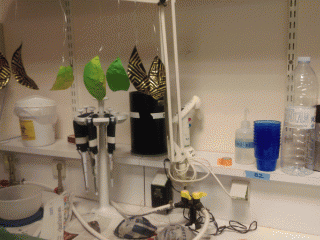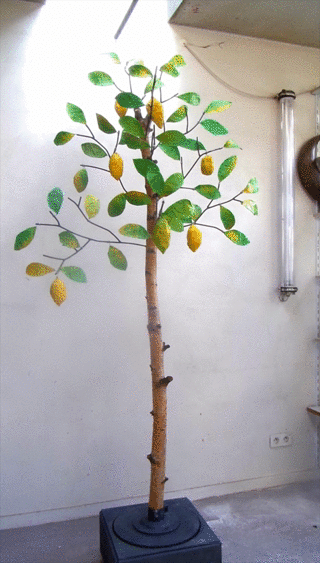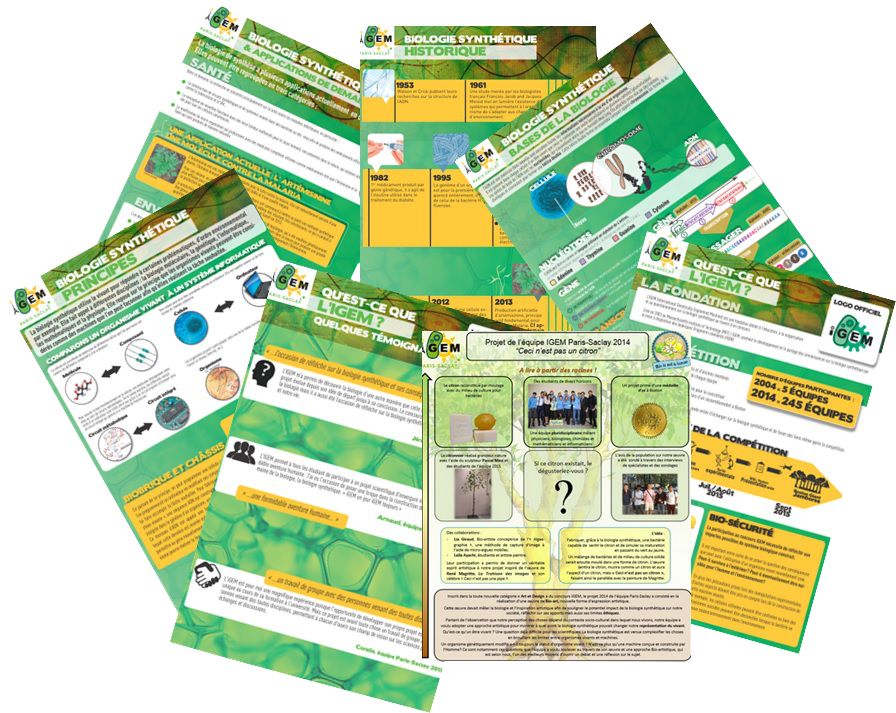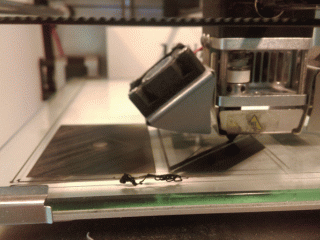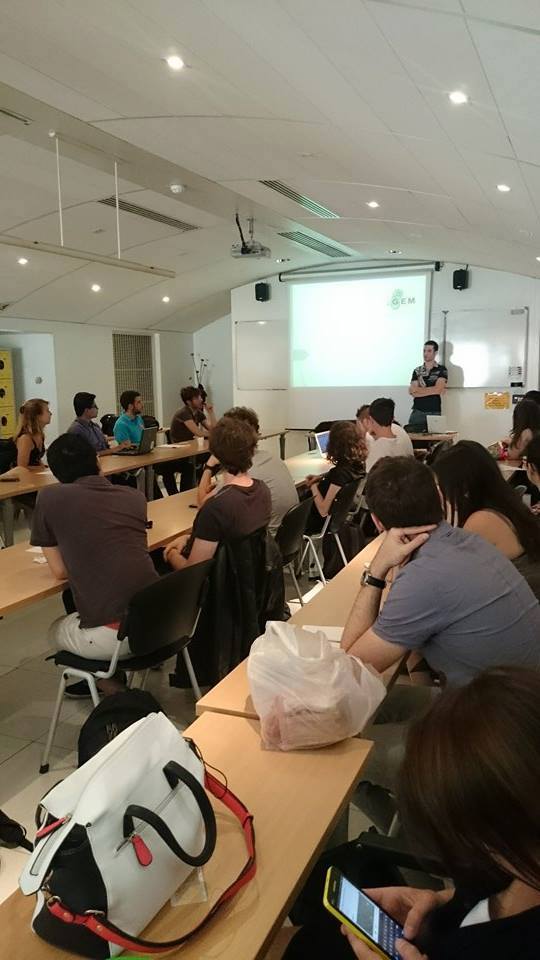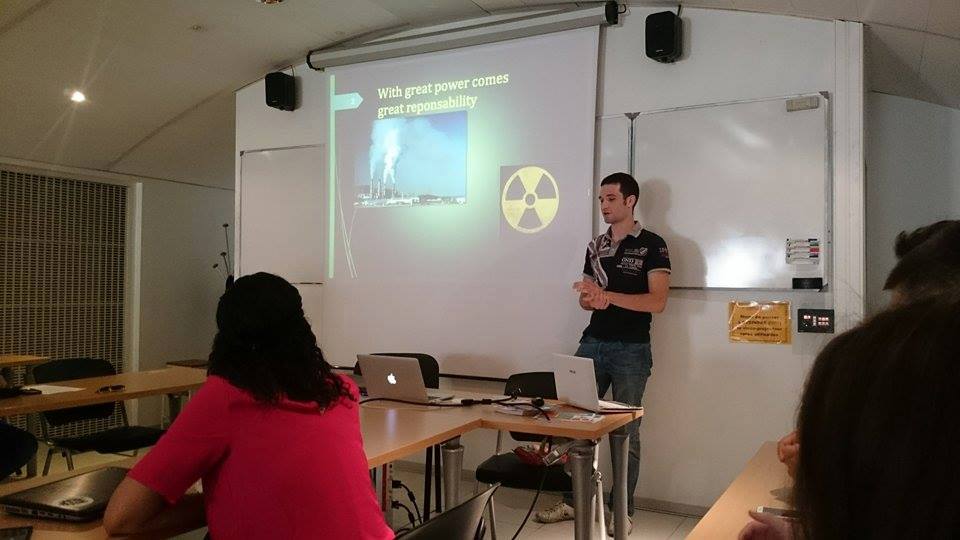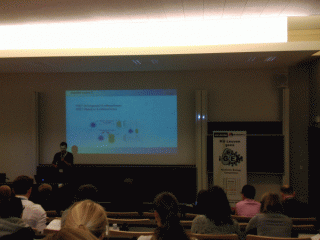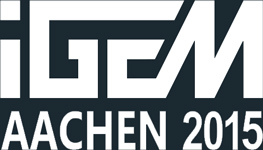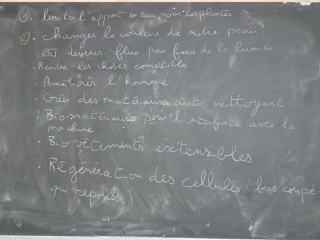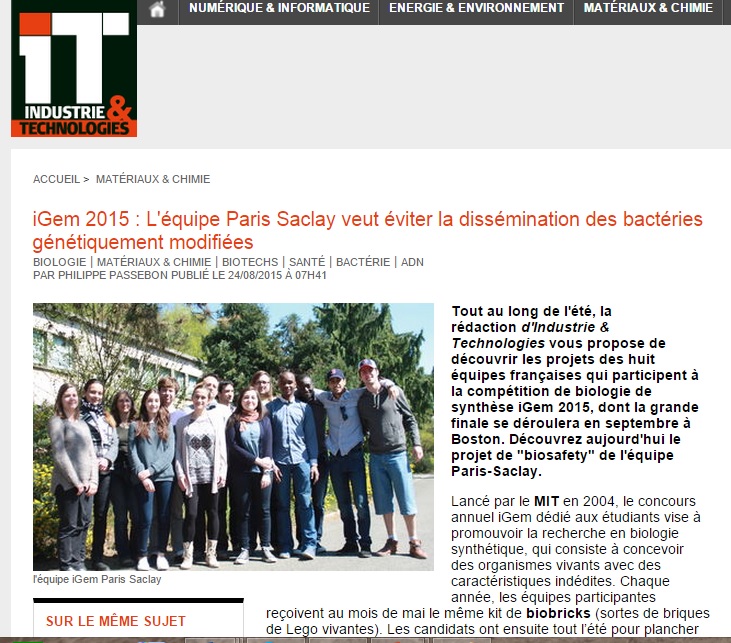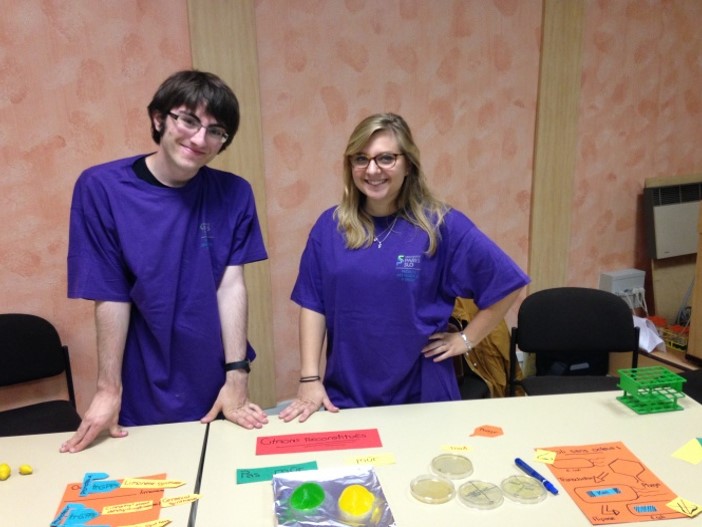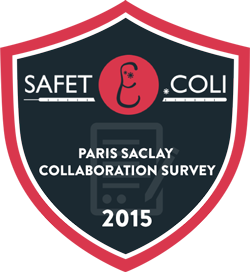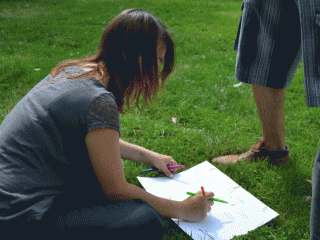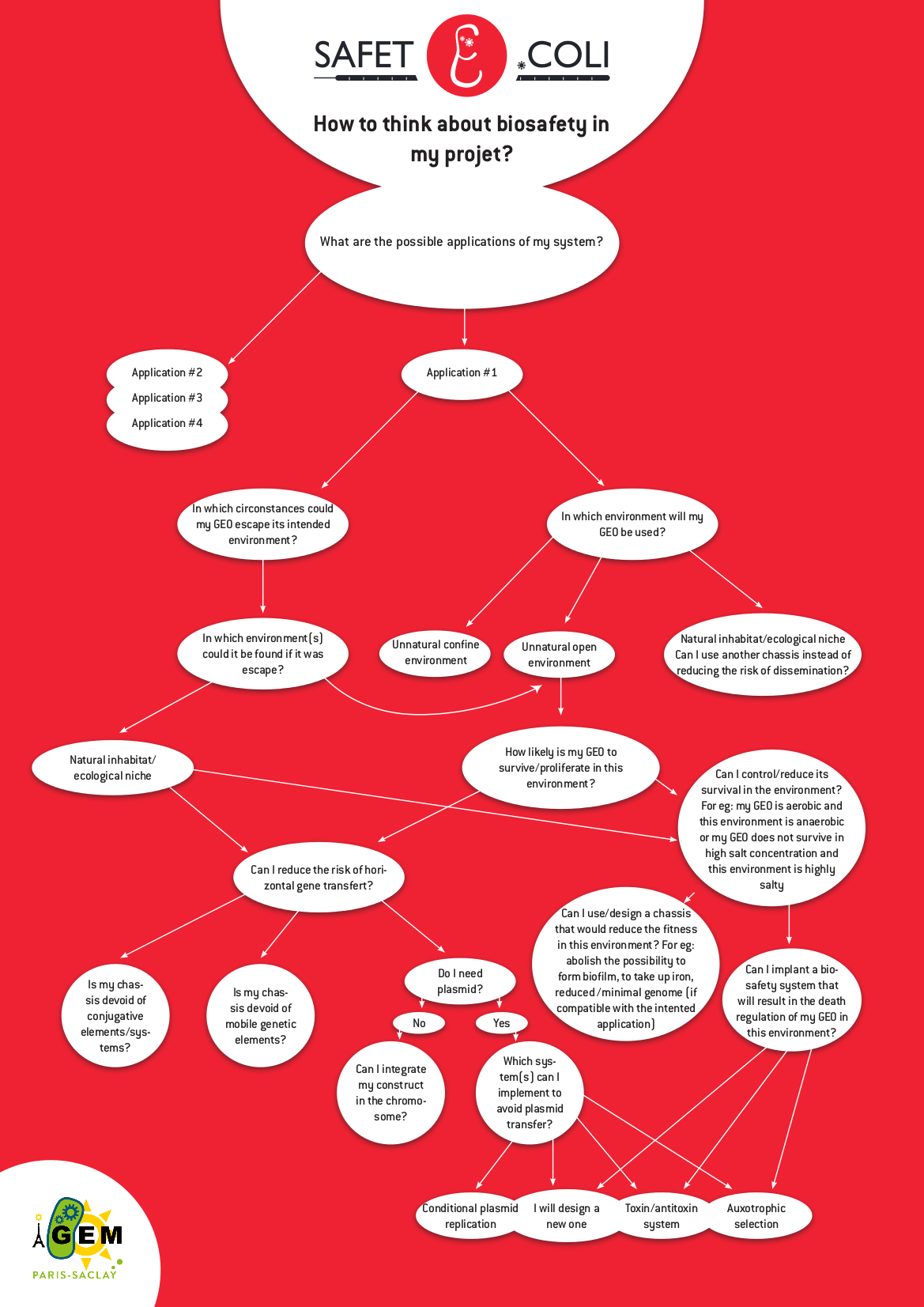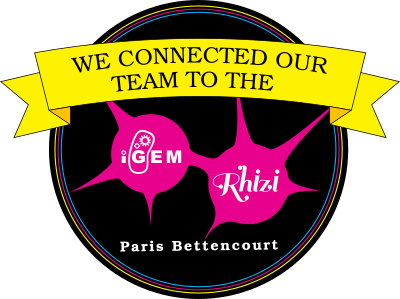Human Practices
Key achievements
- Rising issue of biosafety upon iGEM projects
- Curiositas Art& Sciences Festival
- Popularization of synthetic biology through various cultural activities
- Interacting with the iGEM community over collaborative events.
Curiositas Art& Sciences Festival

Participating in the festival combining art and science is a tradition for the team iGEM Paris -Saclay .This year we decided to continue the uncompleted project of team iGEM Paris-Saclay 2014. We fashioned several posters intended to popularize synthetic biology. Moreover we realized a piece of art in collaboration with a sculptor. This work will be exposed in several exhibitions through the Parisian region.Read more
iGEM Community

One of the main exciting aspects about iGEM competition lies in the multitude of opportunities to meet other people around the world who share this same passion for sciences. These Meet-ups, in addition to be an opportunity to have fun, represent a framework to share experiences and discussions about our respective projects.Read more
Sensitize public to the challenges of synthetic biology

Because making people getting interested in sciences, synthetic biology and more precisely in our project, iGEM Paris-Saclay team made of Popularization one of its priority. We conducted various activities to get to know people interested in sciences but not necessarily coming from a scientific field. We designed different devices to facilitate basic comprehension of synthetic biology and of the SafetE.coli iGEM project. Read more
Collaborations

The incessant growing number of teams joining iGEM competition increases possibilities of collaborations. Therefore, besides the fact that we participated to other team requests, we drove activities to help and interact with other 2015 iGEM teams. Read more
iGEM Prizes
Best Integrated Human Practices
Our project is entirely dedicated to improving biosafety in iGEM and synthetic biology projects. When browsing previous years iGEM projects to understand what participating to the iGEM competition meant, we were struck by the fact that biosafety was often a forgotten aspect in iGEM projects. Even when biosafety was taken into account, it seemed that it was integrated late in the conception of the project, after the choice of the chassis and the design of the system. In fact, we only found one project entirely focusing on biosafety (Paris Bettencourt 2012). This is when we decided to work on helping iGEM teams to better consider this aspect of their project. To determine whether biosafety was still undervalued by iGEM teams in 2015, we prepared a survey asking teams whether they had considered the possible effects of the release of their organism in the environment. Because we wanted to be useful to the community, we also asked which organism they chose as chassis. The results of this survey (Survey results) showed us that (i)biosafety was still not a major concern for many iGEmers who answered our survey and that (ii) Escherichia coli was still the chassis of choice in iGEM projects. This incited us to consider several directions for our project. First we chose to focus on designing biosafety systems for E. coli chassis in the first instance. Second, as some iGEMers seemed to consider that releasing E. coli in the environment was not a problem, as bacteria will die, we decided to investigate whether this was indeed the case ([1]). Third, we thought that we should take into account physical containment as well as biological containment, as this would certainly be useful for devices aimed at being used in the environment (such as biosensors or bioremediation devices) ([2]). For the biological containment aspect of our project, we decided to concentrate on preventing the dissemination of GE E. coli in the environment, as the Paris Bettencourt team 2012 already worked on preventing horizontal gene transfer with their Bware project. We chose to control the life or death of our bacteria using temperature, allowing them to survive in a defined range of temperatures ([3]). Finally, we wanted the future iGEM teams to consider biosafety as an integral part of their projects, and not something to think about when writing the wiki or the safety form. We therefore wrote a Biosafety guide ([4]), which aims at helping iGEM teams to take into account potential biosafety issues at the beginning of the design of their project, rather than after the conception of their system(s).
Education and Public Engagement
We particularly focused on public engagement by building through the year an exhibition taking place during a science and art festival called CURIOSITas. This exhibition comprises a sculpture which is an original way to communicate with public about synthetic biology since it represents an “engineered” lemon tree which has two faces (“natural” vs “engineered”). It aims at making people think about what they will eat in 50 years and how could synthetic biology change their way of thinking about the living. Another interesting approach was the building of 3D Biobricks Legos which are used to make people basically and playfully understand how living organisms are engineered. The exhibition also contained classical posters aimed at popularizing synthetic biology and presenting the iGEM competition. A video presenting interviews of citizens about synthetic biology was also shown to get an idea about the knowledge and opinion of people on engineered living organisms.
CURIOSITas Festival
CURIOSITas is a rotary festival born from the meeting between scientists and artists and is held at Orsay but also transported into different cities of the Parisian region from September 24th to October 24th. iGEM Paris-Saclay team is presenting an exhibition called « This is not a lemon » which is related to last year iGEM Paris-Saclay 2014 project. We decided to continue the story by creating a sculpture made by the 2015 iGEM Paris-Saclay team in collaboration with the sculptor [http://pascal-masi.com/ Pascal Masi]. The project of the iGEM Paris-Saclay team 2014 aims to create reflexion around the following questions:
- What will you eat in 50 years?
- How could synthetic biology change your way of thinking about the living?
Moreover the iGEM exhibition presents synthetic biology and invites public to explore the new frontiers of living. We have planned an interactive installation made by seven posters designed by the 2015 iGEM Paris-Saclay team: describing history, principal and functional applications of synthetic biology.
Also in collaboration with [http://fablabdigiscope.wordpress.com/ Fablab Digiscop], we printed a set of 3D Biobricks Legos composed of a promotor, a coding sequence and a terminator.
To complete our eye-catching exhibition, a video will be available. These short movies present key moments extracted from several interviews made by our team in Paris. The video first shows people’s reflexion about what synthetic biology could be used for and then what ethical issues they think it raises. This is a good way to simplify and integrate concepts of biology engineering and make it accessible to the targeted public of this festival: families, children, youths, students, scientists and artists and all those who want to discover this original project that push the boundaries of art and science.

6th July - Meet up iGEM Pasteur
Attending the Parisian meetup hosted by iGEM Pasteur team, was an opportunity to interact with members of the Parisian teams. The presentations on the different iGEM 2015 projects, although not yet fully accomplished at that time, were sufficient to understand the origin, reflexion, and main challenges of each project conducted by the involved teams (Ionis, Evry, Paris-Bettencourt, and Paris-Pasteur). Additionally, since the meet-up took place at Pasteur Institute, we visited the Pasteur Museum and the house of Louis Pasteur which brought us an overview about his main contributions to biology. Finally we had a funny extra collaboration with Ionis iGEM team: they filmed a short video in which we presented the main lines around our SafetE.coli project.
29th and 30th August - Meet up Bordeaux
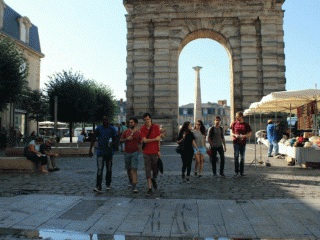
Our team has made experience sharing and interaction with other iGEM teams one of its priorities. Thus we have covered hundred of miles to the city of Bordeaux by joining a scavenger hunt, based on questions about biology and iGEM projects, with team of Bordeaux, KU_Leuven, EPLF-Lausanne, Paris-Pasteur, Aix-Marseille and Toulouse. The meet up gave us a unique opportunity to present our respective projects in a popularize fashion so it could be accessible to an audience unfamiliar with the principles of synthetic biology in the premises of Science Museum in Bordeaux ([http://www.cap-sciences.net Cap Sciences]). A theatre expert gave us a constructive feedbacks and valuable advices about our presentation. Besides popularization activities, we participated to a discussion about the project of the iGEM Pasteur team and answered a survey helping them to consider impact of the throw of plastic waste in the oceans. Finally our team conducted a debate about biosafety and how it is important to consider it in each iGEM project.
7th September - Meet up Leuven
The iGEM team of KU_Leuven invited us to join the synthetic biology and ethical Symposium hosted at KU Campus of Leuven (Belgium). It was a great opportunity for us to present our 2015 project in front of an audience composed of scientists and other iGEM teams (TU Eindhoven, Amsterdam and KU_Leuven). We also have had the chance to attend conferences covering various aspects of the synthetic biology such as the functionality of a minimal synthetic organism, Cell-Free living, or even further by an introducing to the entrepreneurial opportunities of synthetic biology.
21st August - Skype Aachen
We had a chat with both the iGEM Aachen and a Community German lab to lead a reflection on biosafety in experiments and more precisely on potential applications of our SafetE.coli project among iGEM community but also for external labs. The experience was an opportunity to present our model and raise questions about its limits. Moreover, the debate led us to get valuable information about determining vital cellular concentration using a measurement capacity applicable in our physical containment system.
Contact with citizens
Paris-Montagne Association
We collaborated with the Paris-Montagne Association to organize a scientific meeting. Hosted, at the campus of the University Paris-Saclay, the event intended to connect researchers and students coming from disadvantaged backgrounds to introduce them to the practice of research and give them a taste for scientific studies. After explaining fundamentals and challenges of synthetic biology, members of iGEM Paris-Saclay team held a discussion with the group of High school students and help them to think about a future iGEM project. Some ideas such as designing a fluorescent human body appears to be very popular among the group of young students! In order to transpose theory into practice, we offered the young scientists a private visit into the lab ([http://www.i2bc.paris-saclay.fr Institute of Integrative Biology of the Cell]). They had an overview of the necessary tools and techniques commonly used to manipulate genome.
IT Magazine
IT is a web magazine publishing articles covering subjects about industries and technologies. We corresponded with one of their journalists to explain the iGEM competition, the main concepts of synthetic biology and its numerous application. We also presented the concept and objectives of our SafetE.coli project with a simplified view so it can reach the general public. Therefore an [http://www.industrie-techno.com/igem-2015-l-equipe-paris-saclay-veut-eviter-la-dissemination-des-bacteries-genetiquement-modifiees.39207 article dedicated to the project of iGEM Paris-Saclay team was published] on the 28th of August 2015.
La fête de la science (The Science Party)
[http://www.fetedelascience.fr “La fête de la science”] is an national Science Festival undertaken by the Ministry of National Research. Scientific events are held all over the country to promote sciences and interact with people from different horizons. iGEM Paris-Saclay team attends every year events in the campus that hosts students, personal, academic and general public in its laboratories in biology, chemistry, computer science, mathematics, physics and geology. Our team is planning activities for this year festival that will take place on 11th October. The main purpose is to induce debate and promote synthetic biology by exhibiting popularization posters made by our team and potentially meet students interested for joining the iGEM Paris-Saclay 2016 team.
Collaborations
iGEM 2015 teams Biosafety Survey
Our SafetE.coli project implied to know more about the chassis used among iGEM teams.(Survey).Besides, we needed to know more about safety measures undertaken by other teams. A biosafety survey had been made by our team and sent to all 2015 teams asking them to answer few questions about their project. A [http://twitter.com/iGEMParisSaclay/status/639350658852892672 contributing Badge] has been sent to collaborative teams. Many of them did publish it on their wiki. The results from the survey, are considered as background and to justify the frequently of chassis used in SafetE.coli projects. Additionally, it shows the amount of team that are really considering a system to avoid dissemination of their engineered organism in the environment and its limits.
Result of the survey can be accessed here:Survey results
Draw my Biosafety
Seven iGEM teams attended the Bordeaux Meetup. We seized this opportunity to spark reflections concerning every iGEM projects. Therefore we encouraged present teams to think about a safety mechanism suitable for their project. We then helped them to optimize it in order to prevent dissemination of their genetically engineered organism. To make it a funny and traceable experience we asked each team to draw the mechanism developed.
Biosafety Guide
To generalize concern of biosafety among iGEM projects and make it accessible we developed a guide.This document aims to simplify the process in order to conceptualize a biosafety point of view. Moreover this guide rises major questions that a team should consider when starting a biosafety consideration about a project.
Help to create an iGEM team
Members of our team answered the questions and advised some of the founder members of iGEM Paris Pasteur on how to run an iGEM team. iGEM Pasteur is participating for the first time this year to iGEM competition.
iGEM Rhizi
Our team enriched the graphic database, initiated by iGEM Paris-Bettencourt, by sharing key information of our SafetE.coli project. Thus completing the platform with keywords relating to our project make us visible by other iGEM teams. It is a fast and interactive way to find out subjects on which are working other teams. Beside the fact that the platform was available lately in 2015 Competition, Rhizi is promising for future teams. This could certainly become a fast way to find possible collaborations among iGEM community.
Newsletter
Surveys
We have completed the following surveys from various teams.




